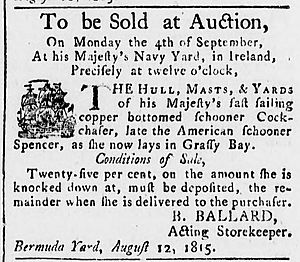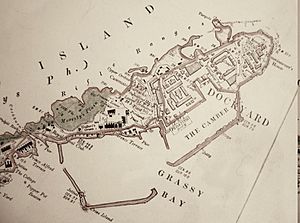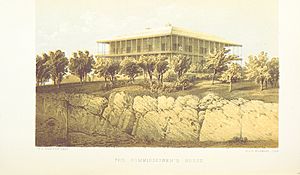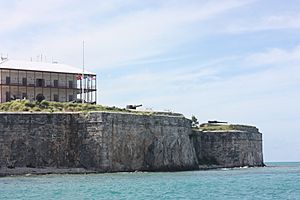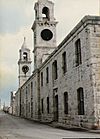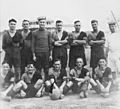Royal Naval Dockyard, Bermuda facts for kids
Quick facts for kids Royal Naval Dockyard, Bermuda |
|
|---|---|
| Bermuda |
|

6-inch guns overlook the Great Sound
|
|
| Type | Shipyard, dockyard, HMD |
| Site information | |
| Operator | Royal Navy |
| Controlled by | Navy Board (1795–1832) Board of Admiralty (1832–1951) Board of Admiralty (1951–1964) and Navy Board (1964–1982) and Government of Bermuda 1951–1982 Navy Board and West End Development Corporation 1982–1995 |
| Site history | |
| Built | 1795 |
| In use | 1795–1995 |
| Battles/wars | American War of 1812 First World War Second World War Cold War |
| Garrison information | |
| Past commanders |
Resident Commissioner Bermuda (1816-1832) Admiral Superintendent Bermuda (1832-1938) Commodore-in-Charge, Bermuda (1938-1946) Commodore West Indies and Senior Naval Officer (1956-1976) |
| Occupants | North America Squadron |
The Royal Naval Dockyard, Bermuda (also known as HMD Bermuda) was a very important base for the Royal Navy in the western Atlantic Ocean. It served as a key naval hub from the time the United States became independent until the end of the Cold War.
Bermuda has always been a useful stop for ships sailing between Europe and the New World. Even before England settled Bermuda in 1609, French privateers (like legal pirates) might have used the islands. Bermudian privateers also helped Britain in many wars.
After the United States gained independence, Britain lost many naval bases on the North American coast. This made Bermuda super important as a new naval base. In 1818, the Royal Naval Dockyard in Bermuda officially became the main British headquarters for the North America Station.
Sailors on shore duty were often listed as crew members of "depot ships." In Bermuda, this was first HMS Terror (1857-1897). Later, the name HMS Malabar was used for the Casemates Naval Barracks. This meant that all naval staff in Bermuda were officially part of HMS Malabar. The base was known as HMS Malabar until it closed in 1995.
Contents
After 1783, Britain faced two main challenges to its power at sea.
French Privateers and Trade Wars
First, Napoleon in France was fighting Britain for control in Europe. He tried to stop British trade by closing European ports. He also sent French privateers from the West Indies to attack British ships in the New World. The Royal Navy was busy in Europe and didn't have enough large warships to chase these small, fast privateers.
American Trade and Sailor Disputes
Second, the United States, a new country, was also a challenge. Britain had relied on American timber for its ships. By 1776, many British merchant ships were American-made. The U.S. stayed neutral in the wars between Britain and France. This allowed American ships to trade with France, which angered Britain. The British Navy was also upset because American ships were hiring British sailors, which made it harder for the Royal Navy to find enough crew.
To fight the French privateers, the Royal Navy started building its own fast ships. These were based on the traditional Bermuda sloop design. In 1795, the first three Bermudian-built ships were ordered. They were fast, 12-gun sloops named HMS Dasher, HMS Driver, and HMS Hunter. Over the next 15 years, many more Bermudian sloops were built. They were used for scouting, carrying messages, and moving important goods quickly. One famous example was HMS Pickle, which carried the news of the British victory at Trafalgar.
Finding a Way to the Great Sound
In 1795, the Royal Navy began buying land in Bermuda. They wanted to build a large naval base and dockyard at the West End. However, there was no known deep channel for large ships to enter the Great Sound. A naval mapmaker, Thomas Hurd, spent 12 years mapping the waters. He finally found a channel through the reefs. This channel is still used today by ships going to the Great Sound and Hamilton Harbour.
Initially, the Royal Navy set up facilities near St. George's, the capital at the East End. This included Convict Bay. But once Hurd's Channel was found, all naval operations moved to the West End.
Building the West End Dockyard
The main part of the new dockyard was built on Ireland Island. At first, local workers were hired. However, most Bermudian men were skilled sailors or shipbuilders, so manual labor was hard to find and expensive.
Convict Labor and Challenges
To get enough workers, the Admiralty started bringing in convicts from Britain and Ireland in 1823. These included some Irish political prisoners. Life for the convicts was very tough. There were strict rules and harsh punishments. Sometimes, there were riots due to the difficult conditions.
The first phase of building was finished in the 1860s. By then, using convicts was no longer popular, so the last ones were sent back to Britain in 1863.
Floating Drydocks for Ship Repair
Bermuda's soft limestone made it hard to build a traditional drydock. A drydock is a place where ships can be taken out of the water for repairs. From 1869, this problem was solved with a floating drydock. This was a large, U-shaped structure that could be partly sunk by filling it with water. A ship would then float in, and the drydock would be emptied, lifting the ship out of the water.
When the dockyard expanded again in the late 1800s, there was still a shortage of local workers. So, the Admiralty brought in laborers from other British West Indian islands. This led to many people moving to Bermuda from the West Indies.
Bermuda's Role in the War of 1812
During the American War of 1812, Bermuda was a key base for the British. The British Navy used Bermuda to block American ports. A British fleet based in Bermuda was active in the Chesapeake Bay from 1813.
In August 1814, British forces sailed from the Dockyard to attack Washington, D.C. This led to the Burning of Washington, where public buildings were set on fire. When the forces returned to Bermuda, they brought back portraits of King George III and Queen Charlotte. These portraits are now in the Bermudian Parliament.
Bermudian privateers also played a big part in the war, capturing 298 American ships.
The Dockyard in the 19th Century
After the War of 1812, the Navy focused on building the Dockyard. The Army also built up its defenses to protect the naval base. Britain started to see Bermuda more as a military base than just a colony.
Bermuda in the World Wars
The Royal Naval Dockyard played a vital role in both World Wars.
First World War Efforts
During World War I, the Dockyard helped protect Allied merchant ships across the Atlantic. Ships from the North America and West Indies Squadrons hunted German raiders. They also escorted convoys of merchant ships that gathered in Bermuda before crossing the Atlantic. German submarines were a major threat to these convoys.
Second World War Operations
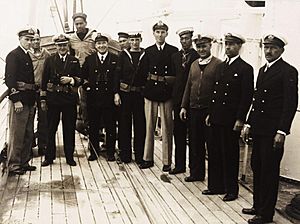
In World War II, the naval base in Bermuda again organized convoys across the Atlantic. Ships would arrive in Bermuda, where they would join larger convoys. These convoys then sailed across the Atlantic, often joining up with ships from Halifax, Canada.
The Fleet Air Arm (the Royal Navy's air force) also provided air patrols from Boaz Island. They used Supermarine Walrus flying boats to look for enemy submarines. Later, the US Navy took over most air patrols from Darrell's Island. The Fleet Air Arm then focused on target-towing for anti-aircraft gun training.
Even though Bermuda was a naval base, its warships were often far away. There was some worry about German battleships attacking the island. However, Bermuda was never attacked.
After World War II, the naval base in Bermuda became less important to the Royal Navy. The United States, once a rival, was now a close ally. The US also built its own naval and air bases in Bermuda under 99-year leases. This meant the US took on most of the responsibility for defending Bermuda. This freed up British forces to go elsewhere.
In 1958, the Royal Navy closed most of the Dockyard facilities. Much of the land was given to the local government for a small fee.
HMS Malabar and Its Closure
The South Yard of the Dockyard stayed open as HM Naval Base, Bermuda. It was officially named HMS Malabar in 1965. It continued to be the base for the North America and West Indies Station. However, it no longer had a drydock for major repairs. Ships needing big fixes had to sail all the way to Portsmouth, England.
The "Senior Naval Officer West Indies" (SNOWI) was also based in Bermuda. This officer was in charge of British naval forces in the Caribbean.
Both HMS Malabar and the Canadian Forces Station Bermuda (a radio station) closed in 1995. This marked the end of 200 years of a permanent Royal Navy presence in Bermuda.
The Dockyard Today: A Tourist Hotspot
After most of the naval base closed in 1957, many buildings fell into disrepair. Storms and lack of care caused a lot of damage.
In the 1980s, Bermuda's growing tourism led to interest in fixing up the dockyard. The idea was to turn it into a tourist attraction. Today, cruise ships regularly dock there during the summer. This area is now called King's Wharf.
The West End Development Corporation (WEDCO) was created in 1982. Its job is to manage the development of the former naval lands. Many old warehouses have been turned into shops for artists. There is also a shopping area in the clock tower building. The old "Keep" area is now home to the National Museum of Bermuda and the Dolphin Quest attraction. You can also find several restaurants there.
More money is being raised to repair the remaining damaged buildings. A second dock for mega-cruise ships has already been built.
Images for kids
-
1831 painting of a three-masted Bermuda sloop of the Royal Navy, entering a West Indies port.
-
HM Dockyard as seen from the Keep by Ana Brassey in 1883, with two warships and the floating drydock
-
floating drydock in Bermuda, 1895
-
America and West Indies Station 1st Division (HMS Dragon, HMS Danae and HMS Despatch) off Admiralty House in 1931 as they depart the Royal Naval Dockyard to exercise on the open ocean
-
The Keep, as seen from the Great Sound
-
Church Parade of the Royal Navy and British Army at the (then under construction) Cathedral in the City of Hamilton, circa 1900



